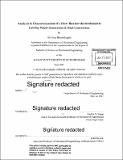| dc.contributor.advisor | Evelyn N. Wang. | en_US |
| dc.contributor.author | Booeshaghi, Ali Sina | en_US |
| dc.contributor.other | Massachusetts Institute of Technology. Department of Mechanical Engineering. | en_US |
| dc.date.accessioned | 2017-12-05T19:18:38Z | |
| dc.date.available | 2017-12-05T19:18:38Z | |
| dc.date.copyright | 2017 | en_US |
| dc.date.issued | 2017 | en_US |
| dc.identifier.uri | http://hdl.handle.net/1721.1/112567 | |
| dc.description | Thesis: S.B., Massachusetts Institute of Technology, Department of Mechanical Engineering, 2017. | en_US |
| dc.description | Cataloged from PDF version of thesis. | en_US |
| dc.description | Includes bibliographical references (pages 53-55). | en_US |
| dc.description.abstract | In this thesis, I analyzed and characterized a new flow thermo-electrochemical cell that generates power from waste-heat, while in parallel convecting this heat away from the source. I also reviewed previous research on the topic of thermo-electric energy generation, governing physics behind thermo-electrochemical energy generation, actual device fabrication, device testing, results, and applications of this technology. Thermo-electric devices (TE devices) exhibit the thermo-electric effect, where temperature gradients and material properties work in tandem to drive electron transfer at electrode surfaces, thereby generating electricity. For example, a typical sold-state TE device such as a bismuth telluride TE device, can generate up to 0.300 mV/K [31]. New reseach has emerged [25, 26, 14] focusing on liquid-based thermo-electrochemical (TEC) cells that take advantage of the temperature dependence of oxidation/reduction chemical reactions to generate electricity. One of the major benefits of these TEC devices over traditional TE devices is a much higher S, = 1.5 mV/K; another is the low cost of manufacturing, making them promising for commercial applications. The new TEC device that I fabricated and studied utilizes a flowing electrolyte instead of a stationary electrolyte. With this new configuration, and a heated boundary condition, I studied both the energy generation and convective heat transfer capabilities of the flowing electrolyte TEC cell. Numerically I obtained a maximum power output and heat transfer coefficient for the TEC cell of Pmax = 2.6 [mu]W and h = 340 W/m²K which corroborates well with the experimentally found value of Pmax = 2.0 [mu]W and h = 450 W/m². K. If employed in data centers, as a device for CPU cooling, with the given power output I found that a 100,000 ft² data center can generate about 21.96 MWh of energy, which at a cost of 0.20 $/kWh can save a data center about 5,000 $/year. More generally, the application of this technology in locations where waste-heat is prevalent, will allow for energy recycling and consequent cost savings. | en_US |
| dc.description.statementofresponsibility | by Ali Sina Booeshaghi. | en_US |
| dc.format.extent | 55 pages | en_US |
| dc.language.iso | eng | en_US |
| dc.publisher | Massachusetts Institute of Technology | en_US |
| dc.rights | MIT theses are protected by copyright. They may be viewed, downloaded, or printed from this source but further reproduction or distribution in any format is prohibited without written permission. | en_US |
| dc.rights.uri | http://dspace.mit.edu/handle/1721.1/7582 | en_US |
| dc.subject | Mechanical Engineering. | en_US |
| dc.title | Analysis & characterization of a flow thermo-electrochemical cell for power generation & heat convection | en_US |
| dc.title.alternative | Analysis and characterization of a flow thermo-electrochemical cell for power generation and heat convection | en_US |
| dc.type | Thesis | en_US |
| dc.description.degree | S.B. | en_US |
| dc.contributor.department | Massachusetts Institute of Technology. Department of Mechanical Engineering | |
| dc.identifier.oclc | 1013188014 | en_US |
